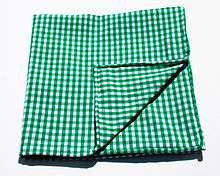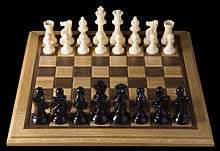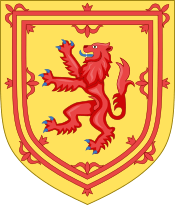Check (pattern)
A check (also checker, Brit: chequer) is a pattern of modified stripes consisting of crossed horizontal and vertical lines forming squares.



Etymology
The word is derived from the ancient Persian language word shah, meaning "king", from the oriental game of chess, played on a squared board, particularly from the expression shah mat, "the king is dead", in modern chess parlance "check-mate". The word entered the French language as echec in the 11th century,[1] thence into English.
Variations
Buffalo check or buffalo plaid has black hashes on a red background. In the United States, it got its name around 1850 when a designer at the Woolrich mill at Chatham's Run in Pennsylvania (who owned a herd of buffalo) copied a pattern known as "Rob Roy" in Scotland. "No. 5310-402 in the Woolrich middleweight fabric collection" became associated with lumberjacks, as those nearby in the Pennsylvania woods were the main customers for the woolen shirts that used it. It became popular in mainstream fashion in the United States in the 90s and 2010s.[2][3]
Windowpane plaid is a pattern of large rectangles or squares in a color contrasting with the main color.[4]
History
Weavers have long produced checked patterns, but fashion trends in fabric vary over time.[5]
Other uses
The check pattern is also used in many areas other than textile styles, for example: on a board used by the medieval Exchequer to perform financial computations, and on a board used for playing checkers and chess, and in heraldry.
The check pattern has a number of symbolic meanings. In auto racing, the chequered flag is displayed at the finishing line to signal that the race has finished. It originates from the "checkers" who watched the finishing line and checked when cars had finished the race. They began using chequered flags to identify themselves.
In some countries, the check pattern has become a symbol of the police. Known as "Sillitoe Tartan", it was first used in Glasgow in the 1930s and was inspired by a pattern worn by some Scottish army regiments. The symbol is used in the United Kingdom, Australia, New Zealand, Norway, Iceland and some cities in the United States (notably Chicago).
Types
- Argyle (pattern)
- Battenburg markings
- Checkered flag
- Diapering
- Flannel
- Gingham
- Houndstooth
- Madras (cloth)
- Plaid (pattern)
- Sillitoe Tartan
- Square tiling
- Stripe (pattern)
- Tartan
- Tattersall (cloth)
Sources
- Harrison, E.S.; Our Scottish District Checks; National Association of Woollen Manufacturers, Edinburgh; 1968 p6.
References
| Wikimedia Commons has media related to Checkered. |
- Larousse Dictionnaire de la Langue Francaise, Lexis, Paris, 1993
- Robert Klara (12 November 2015). "Why the 165-Year-Old Buffalo Check Is 2015's Hot Holiday Pattern". Ad Week.
- Laura Serino (25 November 2013). "A Brief History of Buffalo Plaid". Maine Today.
- windowpane
-
Brackman, Barbara (2010). "Fabric of the Machine Age: 1890-1925 / Ginghams: Checked, Plaid, Striped and Plain". Making History - Quilts & Fabric From 1890-1970: 9 Reproduction Quilt Projects - Historic Notes & Photographs - Dating Your Quilts. Lafayette, California: C&T Publishing Inc. ISBN 9781607053026. Retrieved 3 May 2019.
Weavers have always been able to produce pattern by crossing colored yarns into stripes and checks [...]. But early-twentieth-century fashion embraced simple woven patterns, so a quilt with an abundance of checks, plaids, and stripes may be from 1910 to 1925.



.svg.png)